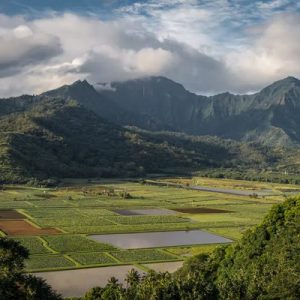In this series, we are taking a closer look at elements in the Hawaiian food systems including innovations and issues. Hawaiian agriculture is unique to the islands and showcases a host of special challenges.
Read on for Carly Wyman’s experience with Hawaiian agriculture. She is the Swette Center’s on-the-ground team member researching Hawai’i’s food, agriculture, and policy. In this series, Carly shares her insights on the unique challenges in the Hawaiian food systems.
Between hauling compost and harvesting sugar cane, during my time as a “wwoofer,” I began to learn about the unique challenges that small farmers of Hawai'i face. With the highest agricultural labor wages in the US, at $23.94 per hour, it’s no wonder so many of Hawai’i’s small farms rely on wwoofers or “work-traders” to fulfill some of their labor needs (U.S. Bureau of Labor Statistics, 2021). (For comparison, agricultural workers in California are paid an average of $20.42 hourly (Ibid.)). This is just one of the high cost drivers that farmers in Hawai'i contend with.
Traditionally, native Hawaiians practiced diversified agforestry, cultivating acres and acres of traditional crops such as kalo (taro), ʻuala (sweet potato), and maiʻa (banana). However, over a hundred years of plantation monocropping of sugarcane and pineapple ensued after Western contact, current-day Hawai'i agriculture is still seeking to find its footing in the wake of the collapse of these industries. Today, Hawai’i is essentially a place of small, diversified farmers, with 66% of farms in the islands being smaller than 9 acres (USDA NASS, 2017).
With a year-round growing season, there is always work to do on the farm. Agricultural pests proliferate due to these consistently warm temperatures and a steady flow of imported plants. Dozens of new alien species are introduced to the islands each year, making it tough for farmers to stay on top of the ever-growing list of potential agricultural pests.
Though many farmers perceive high barriers to organic certification, many utilize “no-spray” practices, including permaculture, traditional native Hawaiian food production, or Korean Natural Farming. All of these sustainable farming techniques serve to address some of the unique challenges of growing in our climate with our geographical isolation. However, the lack of certified organic producers is striking, with less than 2% of all farms in the islands being certified (USDA NASS, 2017, USDA NASS, 2019). This is in large part due to a lack of support on many levels. From a lack of resources for certification to marketing and promotion programs, Hawai'i’s organic and would-be organic producers struggle to navigate the National Organic Standards as applied to our tropical crops and environment (The Kohala Center, 2014).
